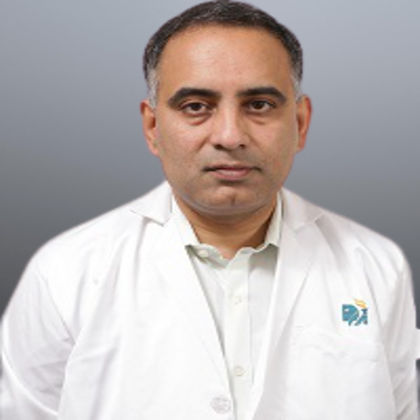Cancer Treatment Options
Navigating cancer begins with understanding the full range of treatment options, their potential impacts, risks, and more. Start your journey here to find the right path forward.

Written by
Last updated on 3rd Jul, 2025
Cancer refers to the uncontrolled growth and spread of abnormal cells affecting various tissues or organs, ranging from blood cancer like leukaemia to solid tumours like breast cancer.
Understanding the available treatment options is important in making well-informed decisions as treatment can vary on a patient’s health, cancer type, and stage.
Surgical Treatment
Surgery is still a cornerstone of cancer treatment, especially for localised tumours.
1. Types of Cancer Surgeries
There are many types of surgery. The types differ based on the purpose of the surgery, the body part requiring surgery, the tissues that need removal, and occasionally, the patient’s preference.
Some of the common types of cancer surgeries include:
Curative Surgery: Complete removal of the cancer tumour.
Preventive Surgery: Removal of tissues that are likely to become cancerous, such as prophylactic mastectomy in cases of breast cancer.
Debulking Surgery: It is used to reduce a tumour’s size when complete removal is not possible. It is often combined with other therapies like radiation or chemotherapy.
Palliative Surgery: It helps in relieving symptoms or complications such as pain or obstruction caused by cancer.
2. When Surgery Is Recommended
Since surgery can treat various cancer types and symptoms, it is one of the most common cancer treatment options.
Cancer surgery is a local treatment, which means it solely targets the cancer’s location in the body. Surgery is best suited when removing solid tumours and cancers that have not spread to other parts of the body.
It is completely possible that surgery is the only cancer treatment that a patient might need. However, it’s also possible that patients might need other treatment methods in addition to surgery.
Radiation Therapy
Radiation therapy is a type of cancer treatment that kills cancer cells and reduces tumours by using high doses of radiation.
1. How Radiation Therapy Works
Radiation therapy can damage the DNA of cancer cells at high dosages, either killing them or stunting their growth.
When a cancer cell’s DNA is permanently damaged, it either stops growing or dies. The body breaks down and destroys the broken-down cancer cells.
Radiation therapy does not outright kill cancer cells. It needs time to be effective. The treatment period can range from days to weeks before the DNA is damaged enough to cause the cancer cells to die.
Cancer cells continue dying weeks or months post-treatment.
2. Types of Radiation Therapy
Radiation therapy consists of two main types: external and internal beam.
External Beam Radiation Therapy (EBRT): In EBRT, cancer cells are targeted by delivering radiation from outside the body. Intensity-modulated radiation therapy (IMRT) and stereotactic body radiation therapy (SBRT) are some techniques that help in precise targeting.
Internal Radiation Therapy (Brachytherapy): This involves putting radioactive material close to or inside the tumour. Brachytherapy is often used to treat breast, prostate, and cervical cancer.
Chemotherapy
Chemotherapy, also known as chemo, is a cancer treatment method that uses drugs to kill cancer cells. Unlike other therapy methods like targeted and radiation therapies, chemotherapy rapidly attacks dividing cells, which includes both cancerous and healthy cells.
Common chemotherapy drugs and their effects include:
Alkylating Agents: These drugs damage the DNA of the cancer cell to prevent it from spreading and reproducing. Altretamine and Bendamustine are two of the commonly used alkylating agents used in chemotherapy.
Antimetabolites: These prevent cancer cells from reproducing by interfering with the DNA and RNA production of cancer cells. Azacitidine and capecitabine are common examples of antimetabolites.
AntiTumour Antibiotics: These antibiotics attach themselves to the cancer cell DNA to limit growth and reproduction. Examples include Epirubicin and Idarubicin.
Topoisomerase Inhibitors: Topoisomerases are enzymes that help in separating DNA needed for replication. Topoisomerase prevents the growth of cancer cells. Etoposide and Irinotecan are commonly used topoisomerase inhibitors.
Mitotic Inhibitors: These inhibitors help in preventing cell reproduction by prohibiting the creation of proteins needed for cell division. Common mitotic inhibitors include Cabazitaxel and Docetaxel.
Targeted Therapy
Targeted therapy offers a more precise approach by only targeting cancer-specific molecules. Targeted therapy is a cancer treatment method that targets and controls proteins that determine cancer growth, reproduction, and spread.
Targeted therapy interferes with the proteins/molecules to stop cancer from spreading while causing the least amount of harm to healthy cells.
Some common targeted therapy drugs include:
Ado-Trastuzumab Emtansine: It combines HER2-binding antibody with chemotherapy drug emtansine (DM-1) to destroy cancer cells as well as stimulate the immune system.
Nivolumab: It binds itself to the protein PD-L1’s surface and stops the suppression of the immune system by cancer cells. It helps the immune system to target and kill cancer cells.
Bevacizumab: It functions by blocking VEGF, a protein that some cancer cells overproduce. By blocking VEGF, it prevents tumours from growing by limiting the growth of new blood vessels that tumours need for development.
Immunotherapy
Immunotherapy uses the body’s immune system to recognise and kill cancer cells. Immunotherapy is categorised as a biological therapy since it uses molecules derived from living things to treat cancer.
Some of the available immunotherapies include:
Checkpoint Inhibitors: These are used to block proteins that cancer cells use to avoid immune responses. Nivolumab (Opdivo) and pembrolizumab (Keytruda) are two examples of checkpoint inhibitors.
CAR T-Cell Therapy: Involves modifying a patient’s T-cells to attack cancer cells more effectively. This therapy is blood-cancer-approved and has shown impressive results.
Cancer Vaccines: These vaccines boost the body’s defence against specific cancer antigens. Some examples of approved therapeutic vaccines include Bacillus Calmette-Guérin (BCG) and Sipuleucel-T.
Hormone Therapy
Hormone therapy works by circulating through the body to target specific hormones. It helps slow or stop the growth of hormone-sensitive cancers by either blocking the production of hormones or interfering with their effects.
Common hormone-sensitive cancers include:
Breast Cancer: Treated with medications like tamoxifen or aromatase inhibitors.
Prostate Cancer: Managed with androgen-deprivation therapy, like leuprolide.
Stem Cell Transplant
Stem cell transplants can be therapeutic, but they are also complicated and need careful planning and recovery. Stem cell transplants are mostly used to treat blood cancers like lymphoma, leukaemia, and multiple myeloma. The process involves replacing damaged or destroyed bone marrow with healthy stem cells, which regenerate new blood cells.
Common stem cell transplants include:
Autologous Transplants: Uses the patient’s own stem cells, collected before undergoing intense chemotherapy or radiation.
Allogeneic Transplants: Uses donor stem cells to attack residual cancer cells.
Integrative and Complementary Therapies
Integrative therapies improve overall health by combining supplementary methods with traditional cancer treatments. Some examples include:
Acupuncture to reduce pain or nausea
Mediation and yoga to reduce stress and improve mental health
Nutritional support to address dietary needs and boost energy levels
Complementary therapies have significant evidence of effectiveness. These include acupuncture for back pain, yoga for insomnia, exercise for anxiety, and supplements like fish oil and probiotics for various other benefits. However, initiating these requires physician guidance and interactions.
Conclusion
There are many cancer treatment options available—hormone therapy, immunotherapy, chemotherapy, targeted therapy, and surgery being some of them. The treatment choice can vary on various factors such as cancer type, stage, and patient preference.
Personalised treatment programs that are based on each patient’s genetics, lifestyle and health boost therapy results. Cancer treatment will only keep getting better with time as healthcare professionals focus on more effective treatments to fight cancer.
Consult Top Oncologists
Consult Top Oncologists

Dr. Tarun Jindal
Uro Oncologist
14 Years • MS (AIIMS, New Delhi), MCh (Gold Medalist), Fellow, VUI, Henry Ford Hospital, Detroit, USA; Robotic and Laparoscopic surgeon
Kolkata
Apollo Multispeciality Hospitals , Kolkata, Kolkata
(100+ Patients)

Dr. Sandeep Muzumder
Radiation Specialist Oncologist
21 Years • MBBS (JIPMER, Pondicherry), MD (AIIMS, New Delhi)
Bhubaneswar
Apollo Hospitals Old Sainik School Road, Bhubaneswar

Dr Nikhil Suresh Ghadyalpatil
Oncologist
18 Years • MBBS, MD (G. Med), DNB (G.Med), MNAMS DM (Medical Oncology - Tata Memorial Hospital) European Certification In Medical Oncology (ECMO) MRCP (Med Onco SCE), PDCR
Hyderabad
Apollo Hospitals Jubilee Hills, Hyderabad

Dr. Raja T
Oncologist
20 Years • MBBS; MD; DM
Chennai
Apollo Hospitals Greams Road, Chennai
(150+ Patients)

Dr. Harsh J Shah
Surgical Oncologist
15 Years • MS, MCh (GI), DrNB (GI)
Ahmedabad
Apollo Hospitals Gandhinagar, Ahmedabad
